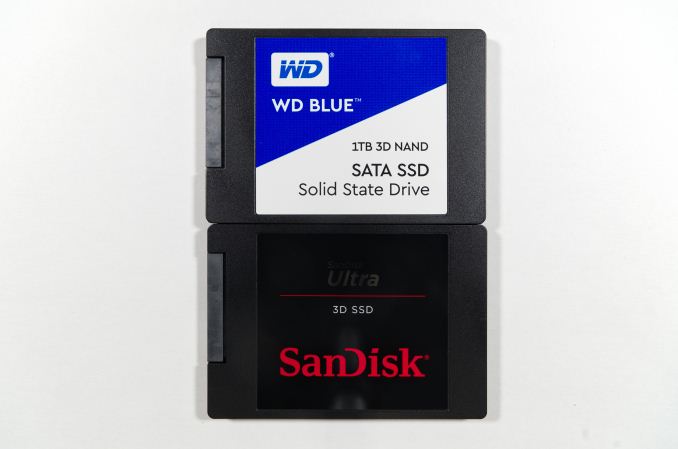One Design, Two Products: The SanDisk Ultra 3D (1TB) and WD Blue 3D (1TB) SSD Reviews, with BiCS 3D NAND
by Billy Tallis on September 14, 2017 9:00 AM ESTConclusion
Compared to last year's WD Blue that used planar TLC NAND flash, the new WD Blue 3D NAND and SanDisk Ultra 3D perform much better on tests where the older drive was weakest. At lower queue depths where the bandwidth of the SATA link was not a bottleneck, the new SSDs delivered significantly better random read and write performance than their predecessors. But the SATA bus has limited how much of a peak improvement 3D NAND could make for the raw performance of Western Digital's SSDs.
Compared to the competing drives on the market today, the new WD Blue 3D NAND and SanDisk Ultra 3D have the performance that is expected of a mainstream SATA SSD. On most real-world workloads, there's no noticeable performance difference between the Ultra 3D and the Samsung 850 EVO. The Ultra 3D also handles being full better than most TLC drives, and does not show the spike in latency that several drives like the Crucial MX300 exhibit. Overall, it is clear that SanDisk is still very good at managing TLC flash and implementing SLC caching in a way that has almost no downsides.
The switch to 3D NAND also brings substantial power savings to the WD Blue 3D NAND and SanDisk Ultra 3D. Idle power is unchanged from the previous generation of drives, but power draw under load is much lower.
| 240-275GB | 480-525GB | 960-1050GB | 2TB | |
| SanDisk Ultra 3D | $89.99 (36¢/GB) | $149.99 (30¢/GB) | $284.99 (29¢/GB) | $549.99 (28¢/GB) |
| WD Blue 3D NAND | $94.99 (38¢/GB) | $164.99 (33¢/GB) | $309.99 (31¢/GB) | $619.99 (31¢/GB) |
| Crucial BX300 | $89.99 (38¢/GB) | $149.99 (31¢/GB) | ||
| Crucial MX300 | $92.99 (34¢/GB) | $149.99 (29¢/GB) | $284.47 (27¢/GB) | $544.62 (27¢/GB) |
| ADATA SU800 | $91.99 (36¢/GB) | $154.99 (30¢/GB) | $269.99 (27¢/GB) | |
| Intel SSD 545s | $99.99 (39¢/GB) | $209.00 (41¢/GB) | ||
| Samsung 850 PRO | $104.99 (41¢/GB) | $209.09 (41¢/GB) | $406.00 (40¢/GB) | $859.99 (42¢/GB) |
| Samsung 850 EVO | $89.99 (36¢/GB) | $147.99 (30¢/GB) | $327.00 (33¢/GB) | $697.99 (35¢/GB) |
Current pricing for the Western Digital SSDs is a bit odd. The WD Blue 3D NAND is more expensive than the SanDisk Ultra 3D by several cents per GB despite the two products being the same under the sticker. The only reason to go with the WD Blue 3D NAND at the moment is for the M.2 version, since the SanDisk Ultra 3D is only available in the 2.5" form factor.
The SanDisk Ultra 3D is priced in between the Crucial MX300 and the Samsung 850 EVO. This matches their relative performance. The performance advantage of the 850 EVO is quite small for most real-world workloads, so its premium mostly buys you a longer warranty and the proven maturity of a product that has been on the market for a long time. If your workload is heavy enough for the difference between the 850 EVO and the Ultra 3D to matter, you should probably be shopping for a NVMe SSD instead of SATA. Meanwhile, the SanDisk Ultra 3D offers higher write endurance ratings and lower power consumption for a slightly lower price. The Ultra 3D makes more sense for most consumers.
Between the SanDisk Ultra 3D and the Crucial MX300, the Ultra 3D should be preferred for heavier workloads. The MX300 will get you an extra 25 or 50GB for the same price, but if you fill up the drive enough for that slightly higher capacity to come into play, the Ultra 3D will perform better. The MX300 still has the advantage in power efficiency and is the better pick for mobile use.
With a good balance of price, performance and power efficiency, the SanDisk Ultra 3D is an easy recommendation.













52 Comments
View All Comments
Rictorhell - Friday, September 15, 2017 - link
Samsung is slated to announce an updated line of new m.2 NVME SSD's at some point this month or in the 4th quarter. Their current m.2 lineup maxes out at 2tb and I've been wondering if they will release a 4tb m.2, even at a sky-high price.Smell This - Thursday, September 14, 2017 - link
Sammy's 'Data Migration' & 'Magician' tools have been bullet-proof for me.Not sure about 'Acronis True Image WD Edition' ... Acronis True Image, surprisingly, has let me down on several occasions.
metayoshi - Friday, September 15, 2017 - link
I can only speak for myself, obviously, but I've been using Acronis True Image for years with no issue. I only use the most basic features like cloning disks and scheduled backups of full disks, but for those it works just fine.mapesdhs - Thursday, September 14, 2017 - link
Billy, any idea what causes those horrible latency spikes with the VX500? They're so big, I was surprised the commentary didn't mention it.Billy Tallis - Thursday, September 14, 2017 - link
Toshiba won't disclose controller architecture details, but all of the smaller capacities of the VX500 have no external DRAM, and the 1TB has only 256GB of external DRAM. We don't know how much memory is in the controller package itself, but the 1TB VX500 certainly has less memory than a typical mainstream SSD even though it's not truly DRAMless. The VX500 also uses SLC caching even though it's a MLC drive, and that tends to lead to greater performance variability (see the Crucial MX200).Glaring_Mistake - Thursday, September 14, 2017 - link
If I remember correctly the VX500 is entirely DRAMless for the smaller capacities that instead use a small amount of SRAM (think it's 32MB).But that was not enough for the 1TB drive so it differs from the other capacitites in that it has a small amount of DRAM at 256MB.
That is still just one fourth of the usual amount of DRAM used for a drive of that capacity however.
At any rate I believe that is the reason as to why latency may suffer a bit; not enough DRAM.
eddieobscurant - Friday, September 15, 2017 - link
"Meanwhile, the SanDisk Ultra 3D offers higher write endurance ratings and lower power consumption for a slightly lower price. The Ultra 3D makes more sense for most consumers."How does it make more sense? The average consumer won't even use the 1/5th of the endurance ratings, but choosing the extra 2 years of warranty of samsung makes a lot of more sense.
Adramtech - Sunday, September 17, 2017 - link
It's amusing to see people complain about the NAND & DRAM shortage and higher prices, and simutaneously say that there's "finally" something to compete with EVO. For years memory was so cheap it put scores of companies out of business and therefore less competition to compete with the EVO. If you want competitive products, these companies need to make money to drive multi-billion dollar Fab & R&D investments. Also, there is no price fixing, the AI revolution, big data, ADAS systems are eating up all the memory and storage. Not to mention HDDs switching over to SSD everywhere you look.kavita - Monday, September 18, 2017 - link
QA Testing the comments on Production.msroadkill612 - Monday, September 18, 2017 - link
Talk about tail wag the dog.That same expensive nand, can be rigged as 500MB/s sata ssd, OR, at about 5x+ that speed if the nvme (aka pcie ssdS) interface is used.
What a waste.
Why? Until very recent AMD TR, niggardly lane quotas on platforms (not unreasonably pre nvme ssdS) mean few have much room for devices that use 4 lanes each.
Sata only sells because its the port folks have readily available on their current pc. Even so, settling for 1/5 of an expensive devices capabilities seems rich.
i.e. - u r mad to buy sata.
Far better to try hard to find a way of improving your interface than settle for gimped ssdS.
Pcie3 nvme should be backwardly compatible w/ pcie2, so by running nvme on pcie2 lanes, they ares slower, but more than double the speed of, sata, and you have invested in a non gimped drives.
While i am at it, If I were buying a ryzen, my plan would be one of each. 2x nvme ssds, on a mobo like msi's am4 x370 moboS, w/ 2x onboard nvme ports, but due to ryzen lane limits, the second must be pcie2. It yields a very fast ssd, and a very, very fast ssd. Not bad.
Thats all your ryzen lanes used after the 16x lane gpu is counted, but u have stacks of ports on the chipset for other needs.
Far better to get an m.2 port pcie adaptor card, lanes permitting, and an nvme ssd.
It grates to hear common remark "oh, dont worry, you wont perceive the nvme speed difference". Yeah right.
The champ 960 pro 500GB nvme is rated for 3400GB/s read seq & 2250~GB/s write. Like u r not going to notice if an app ever swaps out to disk or works on scratch files at such differing relative speeds. BS.
Factor in also that sata ports from chipsets are handicapped in various ways, so it pays to investigate the exact nature of the sata port you use.
A notion for some lane starved users to consider is getting by with 8 lanes for your 16 lane gpu, thus freeing up a juicy 8x pcie3 lanes. Even some gamers credibly say it works as well. Google it.